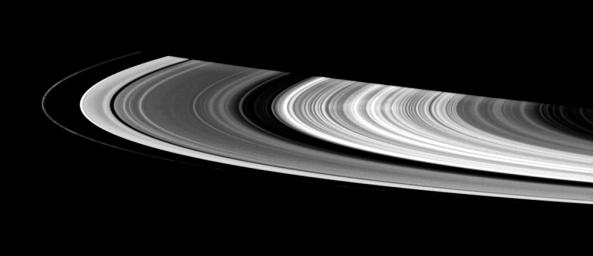
|
Spoke Sighting
- Click the image above for a larger view
- Full-Res JPEG (1006 x 434) (27.9 kB)
- Full-Res TIFF (1006 x 434) (437.3 kB)
Caption:
This contrast-enhanced view shows a faint spoke in Saturn's B ring. These ghostly radial structures were imaged by the Voyager spacecraft in the 1980s. Using the Cassini spacecraft data, scientists are hoping to piece together an understanding of how these mysterious features form.
The Sun-ring-spacecraft viewing angle makes quite a difference in the spokes' appearance: they appear bright against the rings when seen at high phase angles and darker than the rings at lower phase angles. This view was acquired at a phase angle of 133 degrees.
The scene looks toward the lit side of the rings from about 6 degrees below the ringplane.
A train of clumplike structures curls around the F ring at left.
The image was taken in visible light with the Cassini spacecraft wide-angle camera on Sept. 24, 2006 at a distance of approximately 999,000 kilometers (621,000 miles) from Saturn. Image scale is about 56 kilometers (35 miles) per pixel.
Background Info:
The Cassini-Huygens mission is a cooperative project of NASA, the European Space Agency and the Italian Space Agency. The Jet Propulsion Laboratory, a division of the California Institute of Technology in Pasadena, manages the mission for NASA's Science Mission Directorate, Washington, D.C. The Cassini orbiter and its two onboard cameras were designed, developed and assembled at JPL. The imaging operations center is based at the Space Science Institute in Boulder, Colo.
For more information about the Cassini-Huygens mission visit http://saturn.jpl.nasa.gov/home/index.cfm . The Cassini imaging team homepage is at http://ciclops.org .
Cataloging Keywords:
| Name | Value | Additional Values |
|---|---|---|
| Target | Saturn Rings | B Ring, Saturn |
| System | Saturn | |
| Target Type | Ring | Planet |
| Mission | Cassini-Huygens | Voyager |
| Instrument Host | Cassini Orbiter | |
| Host Type | Orbiter | Flyby Spacecraft |
| Instrument | Imaging Science Subsystem (ISS) | |
| Detector | Wide Angle Camera | |
| Extra Keywords | Clump, Grayscale, Visual | |
| Acquisition Date | ||
| Release Date | 2006-11-03 | |
| Date in Caption | ||
| Image Credit | NASA/JPL/Space Science Institute | |
| Source | photojournal.jpl.nasa.gov/catalog/PIA08302 | |
| Identifier | PIA08302 | |
